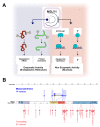NGLY1 Deficiency: A Rare Newly Described Condition with a Typical Presentation
- PMID: 33673403
- PMCID: PMC7996810
- DOI: 10.3390/life11030187
NGLY1 Deficiency: A Rare Newly Described Condition with a Typical Presentation
Abstract
NGLY1 deficiency is the first recognized autosomal recessive disorder of N-linked deglycosylation (NGLY1-CDDG). This severe multisystemic disease is still poorly known and, to date, most cases have been diagnosed through whole exome or genome sequencing. The aim of this study is to provide the clinical, biochemical and molecular description of the first NGLY1-CDDG patient from France along with a literature review. The index case presented with developmental delay, acquired microcephaly, hypotonia, alacrimia, feeding difficulty, and dysmorphic features. Given the complex clinical picture and the multisystemic involvement, a trio-based exome sequencing was conducted and urine oligosaccharides were assessed using mass spectrometry. The exome sequencing revealed a novel variant in the NGLY1 gene in a homozygous state. NGLY1 deficiency was confirmed by the identification of the Neu5Ac1Hex1GlcNAc1-Asn oligosaccharide in the urine of the patient. Literature review revealed the association of some key clinical and biological features such as global developmental delay-hypertransaminasemia, movement disorders, feeding difficulties and alacrima/hypolacrima.
Keywords: NGLY1; NGLY1-CDDG; alacrimia; congenital disorder of deglycosylation; developmental delay; elevated transaminases; hypolacrimia; hypotonia; movement disorder.
Conflict of interest statement
The authors declare no conflict of interest.
Figures


Similar articles
-
NGLY1 deficiency: Novel patient, review of the literature and diagnostic algorithm.JIMD Rep. 2020 Jan 30;51(1):82-88. doi: 10.1002/jmd2.12086. eCollection 2020 Jan. JIMD Rep. 2020. PMID: 32071843 Free PMC article.
-
Novel NGLY1 gene variants in Chinese children with global developmental delay, microcephaly, hypotonia, hypertransaminasemia, alacrimia, and feeding difficulty.J Hum Genet. 2020 Apr;65(4):387-396. doi: 10.1038/s10038-019-0719-9. Epub 2020 Jan 21. J Hum Genet. 2020. PMID: 31965062 Review.
-
NGLY1 deficiency-A rare congenital disorder of deglycosylation.JIMD Rep. 2020 Apr 10;53(1):2-9. doi: 10.1002/jmd2.12108. eCollection 2020 May. JIMD Rep. 2020. PMID: 32395402 Free PMC article.
-
Urine oligosaccharide screening by MALDI-TOF for the identification of NGLY1 deficiency.Mol Genet Metab. 2018 May;124(1):82-86. doi: 10.1016/j.ymgme.2018.03.002. Epub 2018 Mar 10. Mol Genet Metab. 2018. PMID: 29550355 Free PMC article.
-
NGLY1-Related Congenital Disorder of Deglycosylation.2018 Feb 8. In: Adam MP, Feldman J, Mirzaa GM, Pagon RA, Wallace SE, Amemiya A, editors. GeneReviews® [Internet]. Seattle (WA): University of Washington, Seattle; 1993–2025. 2018 Feb 8. In: Adam MP, Feldman J, Mirzaa GM, Pagon RA, Wallace SE, Amemiya A, editors. GeneReviews® [Internet]. Seattle (WA): University of Washington, Seattle; 1993–2025. PMID: 29419975 Free Books & Documents. Review.
Cited by
-
NGLY1 deficiency: estimated incidence, clinical features, and genotypic spectrum from the NGLY1 Registry.Orphanet J Rare Dis. 2022 Dec 17;17(1):440. doi: 10.1186/s13023-022-02592-3. Orphanet J Rare Dis. 2022. PMID: 36528660 Free PMC article.
-
N-glycoproteomics reveals distinct glycosylation alterations in NGLY1-deficient patient-derived dermal fibroblasts.J Inherit Metab Dis. 2023 Jan;46(1):76-91. doi: 10.1002/jimd.12557. Epub 2022 Oct 4. J Inherit Metab Dis. 2023. PMID: 36102038 Free PMC article.
-
Functional prediction of the potential NGLY1 mutations associated with rare disease CDG.Heliyon. 2024 Apr 6;10(8):e28787. doi: 10.1016/j.heliyon.2024.e28787. eCollection 2024 Apr 30. Heliyon. 2024. PMID: 38628705 Free PMC article.
-
NGLY1 Deficiency, a Congenital Disorder of Deglycosylation: From Disease Gene Function to Pathophysiology.Cells. 2022 Mar 29;11(7):1155. doi: 10.3390/cells11071155. Cells. 2022. PMID: 35406718 Free PMC article. Review.
-
Structural and Functional Characterization of N-Glycanase-1 Pathogenic Variants.Cells. 2025 Jul 7;14(13):1036. doi: 10.3390/cells14131036. Cells. 2025. PMID: 40643555 Free PMC article.
References
-
- Caglayan A.O., Comu S., Baranoski J.F., Parman Y., Kaymakçalan H., Akgumus G.T., Caglar C., Dolen D., Erson-Omay E.Z., Harmanci A.S., et al. Ngly1 mutation causes neuromotor impairment, intellectual disability, and neuropathy. Eur. J. Med. Genet. 2015;58:39–43. doi: 10.1016/j.ejmg.2014.08.008. - DOI - PMC - PubMed
Publication types
LinkOut - more resources
Full Text Sources
Other Literature Sources

